Analyzing Education: China and New Zealand's Cultural Context
VerifiedAdded on 2023/06/03
|10
|2420
|469
Report
AI Summary
This report provides a comprehensive analysis of the differences between the education systems of China and New Zealand, focusing on the system itself, the ideologies underpinning it, teaching methods, and learning styles. It highlights China's traditional, patriotism-focused approach versus New Zealand's more modern, liberal, and interactive system. The Chinese system emphasizes structured learning and patriotism, while New Zealand promotes inclusivity and interactive teaching methods. The report also offers recommendations for improvement, suggesting that China incorporate more interactive learning styles and New Zealand adopt successful elements from the Chinese system, while both countries should integrate modern techniques. This analysis contributes to a broader understanding of intercultural dynamics within education.

Running head: CONTEMPORARY CHINESE SOCIETY
THE DIFFERENCE BETWEEN CHINESE EDUCATION AND NZ EDUCATION
Name of the Student
Name of the University
Author Notes
THE DIFFERENCE BETWEEN CHINESE EDUCATION AND NZ EDUCATION
Name of the Student
Name of the University
Author Notes
Paraphrase This Document
Need a fresh take? Get an instant paraphrase of this document with our AI Paraphraser

1
CONTEMPORARY CHINESE SOCIETY
Executive Summary
The aim of the report is to analyse the differences between the educational systems of New
Zealand and China based on the system of education, the ideology being the system of
education, the learning and the teaching style involved in the system. The following
assessment also includes a few recommendations for the betterment of the system in lieu of
the comparison. The overall analysis of the system is to assure the fact that the educational
system of the country has betterment of the system. The overall system of the two countries
when contrasted showcases the difference in the system which is due to the overview – one
being prone to traditional and other utterly modern.
CONTEMPORARY CHINESE SOCIETY
Executive Summary
The aim of the report is to analyse the differences between the educational systems of New
Zealand and China based on the system of education, the ideology being the system of
education, the learning and the teaching style involved in the system. The following
assessment also includes a few recommendations for the betterment of the system in lieu of
the comparison. The overall analysis of the system is to assure the fact that the educational
system of the country has betterment of the system. The overall system of the two countries
when contrasted showcases the difference in the system which is due to the overview – one
being prone to traditional and other utterly modern.

2
CONTEMPORARY CHINESE SOCIETY
Table of Contents
1. Introduction........................................................................................................................3
2. Chinese education and NZ education in terms of education system.................................3
3. Chinese education and NZ education in terms of ideology behind the system.................4
4. Chinese education and NZ education in terms of teaching methods.................................5
5. Chinese education and NZ education in terms of learning styles......................................6
6. Recommendations and Conclusion.................................................................................7
7. References..........................................................................................................................8
CONTEMPORARY CHINESE SOCIETY
Table of Contents
1. Introduction........................................................................................................................3
2. Chinese education and NZ education in terms of education system.................................3
3. Chinese education and NZ education in terms of ideology behind the system.................4
4. Chinese education and NZ education in terms of teaching methods.................................5
5. Chinese education and NZ education in terms of learning styles......................................6
6. Recommendations and Conclusion.................................................................................7
7. References..........................................................................................................................8
⊘ This is a preview!⊘
Do you want full access?
Subscribe today to unlock all pages.

Trusted by 1+ million students worldwide
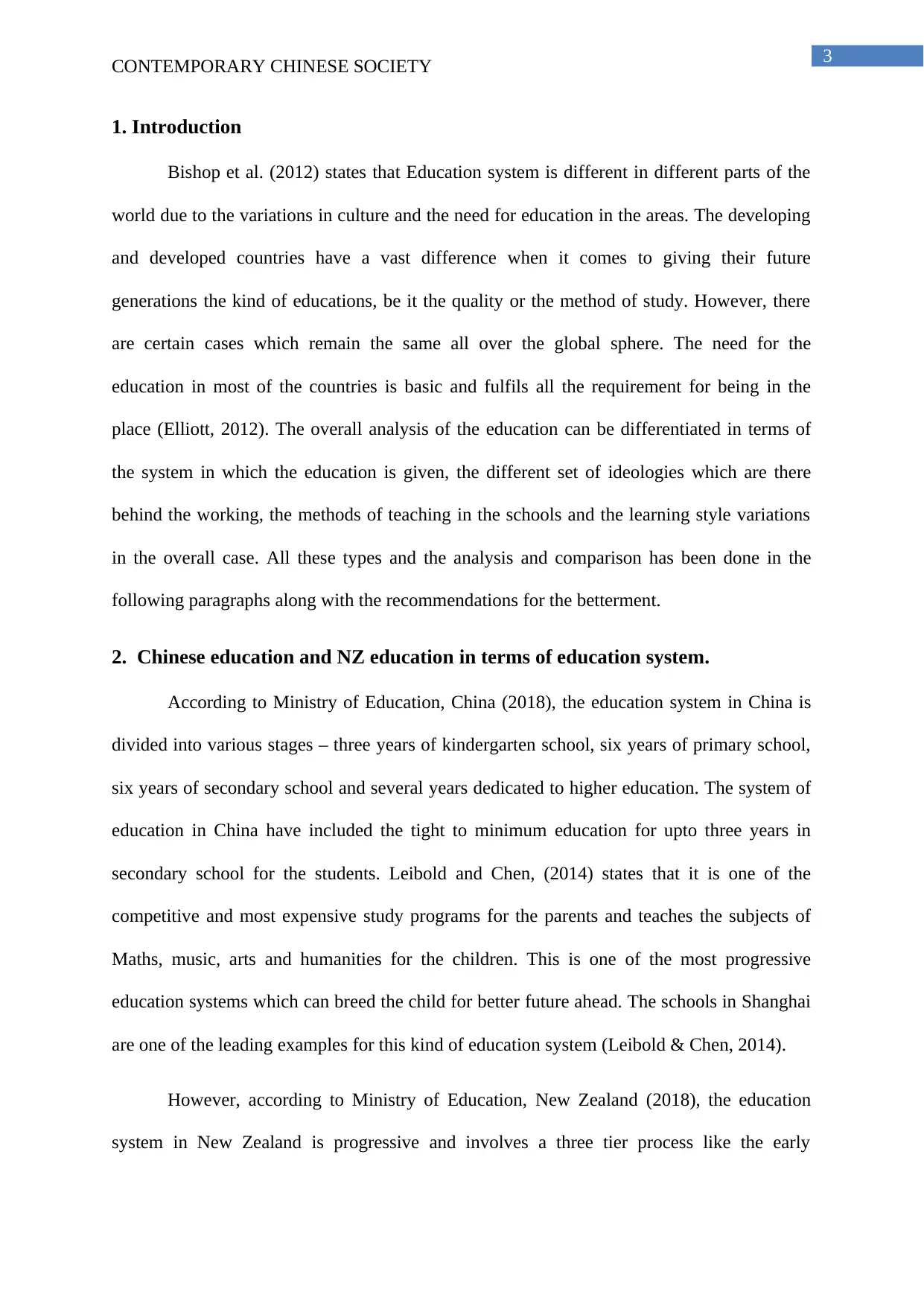
3
CONTEMPORARY CHINESE SOCIETY
1. Introduction
Bishop et al. (2012) states that Education system is different in different parts of the
world due to the variations in culture and the need for education in the areas. The developing
and developed countries have a vast difference when it comes to giving their future
generations the kind of educations, be it the quality or the method of study. However, there
are certain cases which remain the same all over the global sphere. The need for the
education in most of the countries is basic and fulfils all the requirement for being in the
place (Elliott, 2012). The overall analysis of the education can be differentiated in terms of
the system in which the education is given, the different set of ideologies which are there
behind the working, the methods of teaching in the schools and the learning style variations
in the overall case. All these types and the analysis and comparison has been done in the
following paragraphs along with the recommendations for the betterment.
2. Chinese education and NZ education in terms of education system.
According to Ministry of Education, China (2018), the education system in China is
divided into various stages – three years of kindergarten school, six years of primary school,
six years of secondary school and several years dedicated to higher education. The system of
education in China have included the tight to minimum education for upto three years in
secondary school for the students. Leibold and Chen, (2014) states that it is one of the
competitive and most expensive study programs for the parents and teaches the subjects of
Maths, music, arts and humanities for the children. This is one of the most progressive
education systems which can breed the child for better future ahead. The schools in Shanghai
are one of the leading examples for this kind of education system (Leibold & Chen, 2014).
However, according to Ministry of Education, New Zealand (2018), the education
system in New Zealand is progressive and involves a three tier process like the early
CONTEMPORARY CHINESE SOCIETY
1. Introduction
Bishop et al. (2012) states that Education system is different in different parts of the
world due to the variations in culture and the need for education in the areas. The developing
and developed countries have a vast difference when it comes to giving their future
generations the kind of educations, be it the quality or the method of study. However, there
are certain cases which remain the same all over the global sphere. The need for the
education in most of the countries is basic and fulfils all the requirement for being in the
place (Elliott, 2012). The overall analysis of the education can be differentiated in terms of
the system in which the education is given, the different set of ideologies which are there
behind the working, the methods of teaching in the schools and the learning style variations
in the overall case. All these types and the analysis and comparison has been done in the
following paragraphs along with the recommendations for the betterment.
2. Chinese education and NZ education in terms of education system.
According to Ministry of Education, China (2018), the education system in China is
divided into various stages – three years of kindergarten school, six years of primary school,
six years of secondary school and several years dedicated to higher education. The system of
education in China have included the tight to minimum education for upto three years in
secondary school for the students. Leibold and Chen, (2014) states that it is one of the
competitive and most expensive study programs for the parents and teaches the subjects of
Maths, music, arts and humanities for the children. This is one of the most progressive
education systems which can breed the child for better future ahead. The schools in Shanghai
are one of the leading examples for this kind of education system (Leibold & Chen, 2014).
However, according to Ministry of Education, New Zealand (2018), the education
system in New Zealand is progressive and involves a three tier process like the early
Paraphrase This Document
Need a fresh take? Get an instant paraphrase of this document with our AI Paraphraser
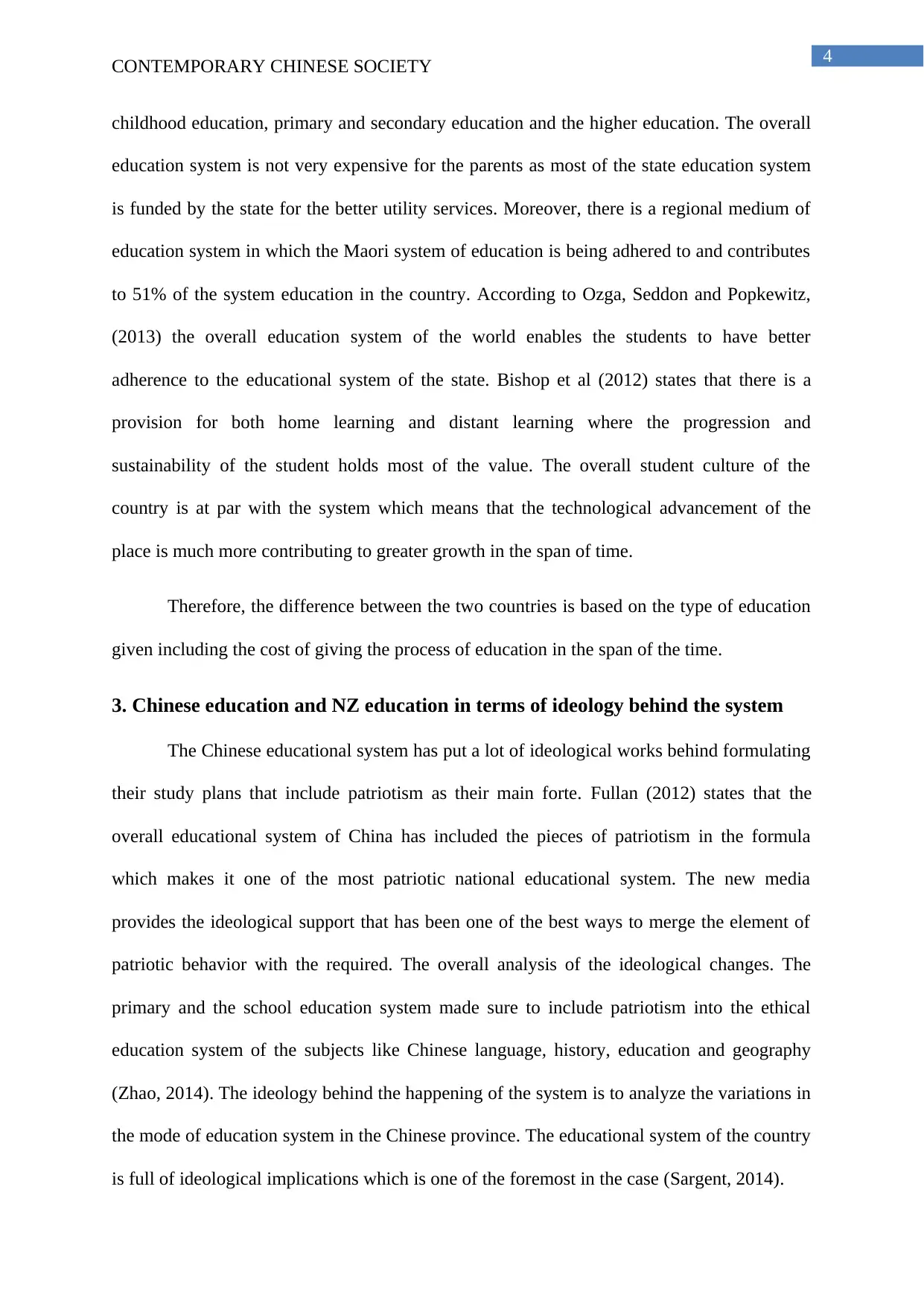
4
CONTEMPORARY CHINESE SOCIETY
childhood education, primary and secondary education and the higher education. The overall
education system is not very expensive for the parents as most of the state education system
is funded by the state for the better utility services. Moreover, there is a regional medium of
education system in which the Maori system of education is being adhered to and contributes
to 51% of the system education in the country. According to Ozga, Seddon and Popkewitz,
(2013) the overall education system of the world enables the students to have better
adherence to the educational system of the state. Bishop et al (2012) states that there is a
provision for both home learning and distant learning where the progression and
sustainability of the student holds most of the value. The overall student culture of the
country is at par with the system which means that the technological advancement of the
place is much more contributing to greater growth in the span of time.
Therefore, the difference between the two countries is based on the type of education
given including the cost of giving the process of education in the span of the time.
3. Chinese education and NZ education in terms of ideology behind the system
The Chinese educational system has put a lot of ideological works behind formulating
their study plans that include patriotism as their main forte. Fullan (2012) states that the
overall educational system of China has included the pieces of patriotism in the formula
which makes it one of the most patriotic national educational system. The new media
provides the ideological support that has been one of the best ways to merge the element of
patriotic behavior with the required. The overall analysis of the ideological changes. The
primary and the school education system made sure to include patriotism into the ethical
education system of the subjects like Chinese language, history, education and geography
(Zhao, 2014). The ideology behind the happening of the system is to analyze the variations in
the mode of education system in the Chinese province. The educational system of the country
is full of ideological implications which is one of the foremost in the case (Sargent, 2014).
CONTEMPORARY CHINESE SOCIETY
childhood education, primary and secondary education and the higher education. The overall
education system is not very expensive for the parents as most of the state education system
is funded by the state for the better utility services. Moreover, there is a regional medium of
education system in which the Maori system of education is being adhered to and contributes
to 51% of the system education in the country. According to Ozga, Seddon and Popkewitz,
(2013) the overall education system of the world enables the students to have better
adherence to the educational system of the state. Bishop et al (2012) states that there is a
provision for both home learning and distant learning where the progression and
sustainability of the student holds most of the value. The overall student culture of the
country is at par with the system which means that the technological advancement of the
place is much more contributing to greater growth in the span of time.
Therefore, the difference between the two countries is based on the type of education
given including the cost of giving the process of education in the span of the time.
3. Chinese education and NZ education in terms of ideology behind the system
The Chinese educational system has put a lot of ideological works behind formulating
their study plans that include patriotism as their main forte. Fullan (2012) states that the
overall educational system of China has included the pieces of patriotism in the formula
which makes it one of the most patriotic national educational system. The new media
provides the ideological support that has been one of the best ways to merge the element of
patriotic behavior with the required. The overall analysis of the ideological changes. The
primary and the school education system made sure to include patriotism into the ethical
education system of the subjects like Chinese language, history, education and geography
(Zhao, 2014). The ideology behind the happening of the system is to analyze the variations in
the mode of education system in the Chinese province. The educational system of the country
is full of ideological implications which is one of the foremost in the case (Sargent, 2014).
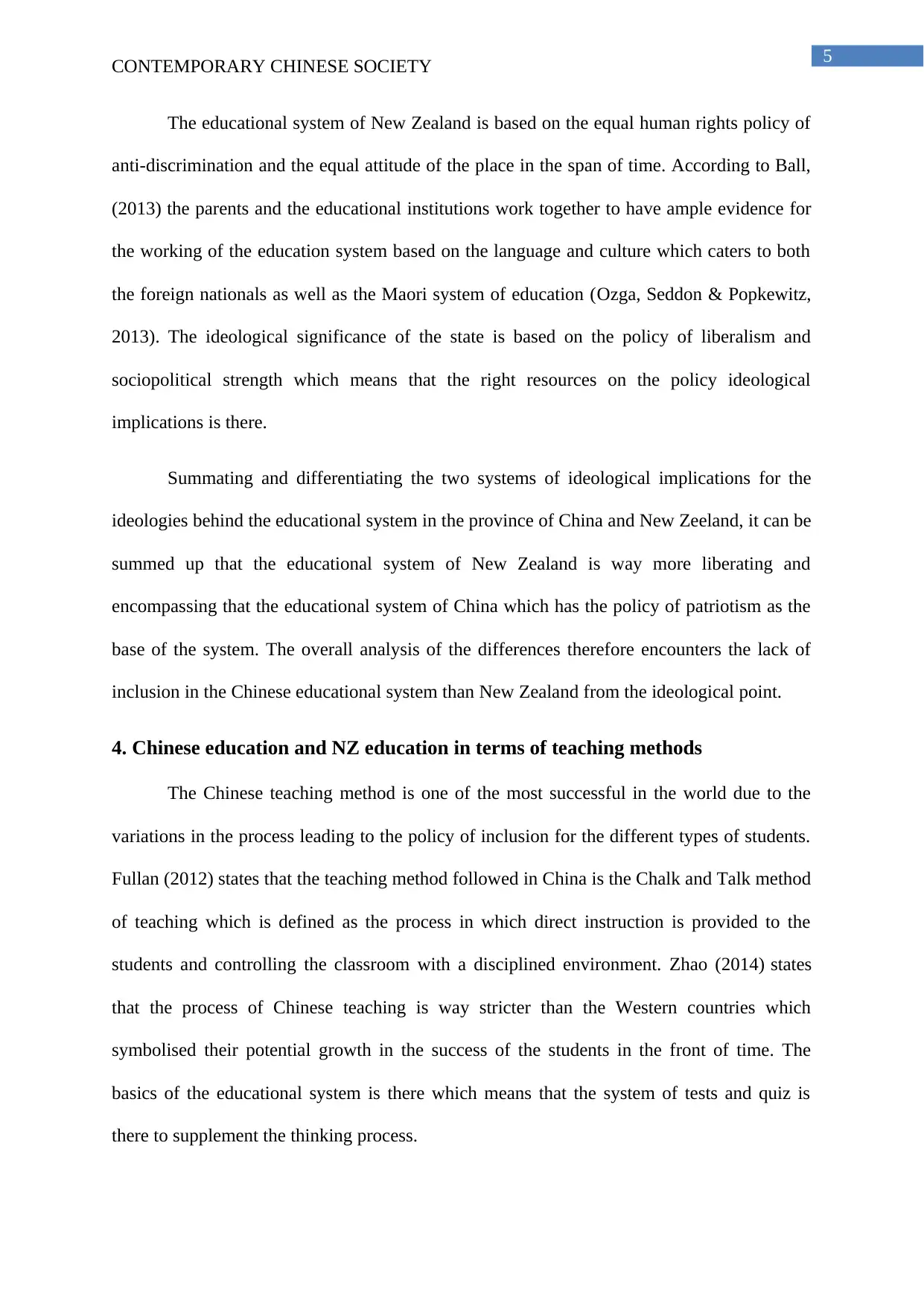
5
CONTEMPORARY CHINESE SOCIETY
The educational system of New Zealand is based on the equal human rights policy of
anti-discrimination and the equal attitude of the place in the span of time. According to Ball,
(2013) the parents and the educational institutions work together to have ample evidence for
the working of the education system based on the language and culture which caters to both
the foreign nationals as well as the Maori system of education (Ozga, Seddon & Popkewitz,
2013). The ideological significance of the state is based on the policy of liberalism and
sociopolitical strength which means that the right resources on the policy ideological
implications is there.
Summating and differentiating the two systems of ideological implications for the
ideologies behind the educational system in the province of China and New Zeeland, it can be
summed up that the educational system of New Zealand is way more liberating and
encompassing that the educational system of China which has the policy of patriotism as the
base of the system. The overall analysis of the differences therefore encounters the lack of
inclusion in the Chinese educational system than New Zealand from the ideological point.
4. Chinese education and NZ education in terms of teaching methods
The Chinese teaching method is one of the most successful in the world due to the
variations in the process leading to the policy of inclusion for the different types of students.
Fullan (2012) states that the teaching method followed in China is the Chalk and Talk method
of teaching which is defined as the process in which direct instruction is provided to the
students and controlling the classroom with a disciplined environment. Zhao (2014) states
that the process of Chinese teaching is way stricter than the Western countries which
symbolised their potential growth in the success of the students in the front of time. The
basics of the educational system is there which means that the system of tests and quiz is
there to supplement the thinking process.
CONTEMPORARY CHINESE SOCIETY
The educational system of New Zealand is based on the equal human rights policy of
anti-discrimination and the equal attitude of the place in the span of time. According to Ball,
(2013) the parents and the educational institutions work together to have ample evidence for
the working of the education system based on the language and culture which caters to both
the foreign nationals as well as the Maori system of education (Ozga, Seddon & Popkewitz,
2013). The ideological significance of the state is based on the policy of liberalism and
sociopolitical strength which means that the right resources on the policy ideological
implications is there.
Summating and differentiating the two systems of ideological implications for the
ideologies behind the educational system in the province of China and New Zeeland, it can be
summed up that the educational system of New Zealand is way more liberating and
encompassing that the educational system of China which has the policy of patriotism as the
base of the system. The overall analysis of the differences therefore encounters the lack of
inclusion in the Chinese educational system than New Zealand from the ideological point.
4. Chinese education and NZ education in terms of teaching methods
The Chinese teaching method is one of the most successful in the world due to the
variations in the process leading to the policy of inclusion for the different types of students.
Fullan (2012) states that the teaching method followed in China is the Chalk and Talk method
of teaching which is defined as the process in which direct instruction is provided to the
students and controlling the classroom with a disciplined environment. Zhao (2014) states
that the process of Chinese teaching is way stricter than the Western countries which
symbolised their potential growth in the success of the students in the front of time. The
basics of the educational system is there which means that the system of tests and quiz is
there to supplement the thinking process.
⊘ This is a preview!⊘
Do you want full access?
Subscribe today to unlock all pages.

Trusted by 1+ million students worldwide

6
CONTEMPORARY CHINESE SOCIETY
However, the teaching style followed in the state of New Zealand is way different
from the overall Chinese teaching methods from the teaching style implied by the interactive
courses of study which is being followed in the case where the students and the teachers
converse with interaction in the process to have a detailed analysis for the benefits of the
students in the course of the time (Ball, 2013). The teaching includes more liberal methods of
teaching the people which also ensured that the people who were given the interaction were
made aware of the process of teaching in the span of time.
Summating and differentiating the two teaching methods from the two countries, it
can be said that the Chinese follow a traditional methods of teaching which is being followed
by most of the countries whereas the New Zealand follows the more liberal and worldly
methods of teaching process.
5. Chinese education and NZ education in terms of learning styles
The Chinese students learning style is one of the most passive in the world due to the
strict environment being followed in the classroom and the educational institutions. Trilling
and Fadel, (2012) states that the overall analysis of the learning styles of the students
belonging to the Chinese education is there for the amount of complications that is present in
the overall style of the sense. The students of the country are passive and only follow the
traditional method which means that the overall analysis of the educational system of the
country is based upon the heights of one-direction teaching in which the direction provided
by the teacher is ultimate with little or no analysis for the interaction process involved
(Trilling and Fadel, 2012).
Barro and Lee, (2013) states that the New Zealand teaching process involves both the
students and the teachers who are interactive to the core and make sure that the process of
teaching is both sided which means that the overall analysis of the educational system as well
CONTEMPORARY CHINESE SOCIETY
However, the teaching style followed in the state of New Zealand is way different
from the overall Chinese teaching methods from the teaching style implied by the interactive
courses of study which is being followed in the case where the students and the teachers
converse with interaction in the process to have a detailed analysis for the benefits of the
students in the course of the time (Ball, 2013). The teaching includes more liberal methods of
teaching the people which also ensured that the people who were given the interaction were
made aware of the process of teaching in the span of time.
Summating and differentiating the two teaching methods from the two countries, it
can be said that the Chinese follow a traditional methods of teaching which is being followed
by most of the countries whereas the New Zealand follows the more liberal and worldly
methods of teaching process.
5. Chinese education and NZ education in terms of learning styles
The Chinese students learning style is one of the most passive in the world due to the
strict environment being followed in the classroom and the educational institutions. Trilling
and Fadel, (2012) states that the overall analysis of the learning styles of the students
belonging to the Chinese education is there for the amount of complications that is present in
the overall style of the sense. The students of the country are passive and only follow the
traditional method which means that the overall analysis of the educational system of the
country is based upon the heights of one-direction teaching in which the direction provided
by the teacher is ultimate with little or no analysis for the interaction process involved
(Trilling and Fadel, 2012).
Barro and Lee, (2013) states that the New Zealand teaching process involves both the
students and the teachers who are interactive to the core and make sure that the process of
teaching is both sided which means that the overall analysis of the educational system as well
Paraphrase This Document
Need a fresh take? Get an instant paraphrase of this document with our AI Paraphraser
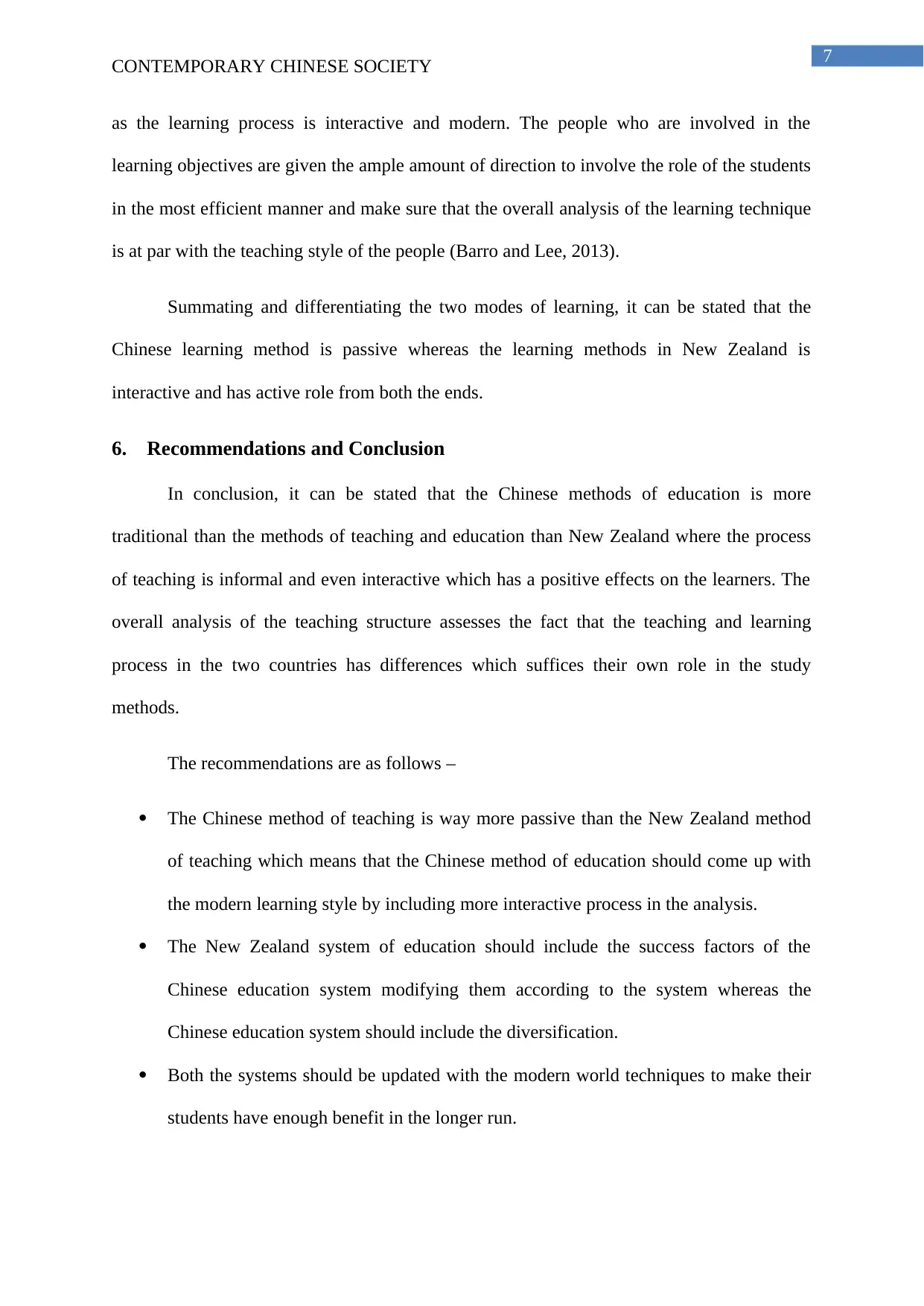
7
CONTEMPORARY CHINESE SOCIETY
as the learning process is interactive and modern. The people who are involved in the
learning objectives are given the ample amount of direction to involve the role of the students
in the most efficient manner and make sure that the overall analysis of the learning technique
is at par with the teaching style of the people (Barro and Lee, 2013).
Summating and differentiating the two modes of learning, it can be stated that the
Chinese learning method is passive whereas the learning methods in New Zealand is
interactive and has active role from both the ends.
6. Recommendations and Conclusion
In conclusion, it can be stated that the Chinese methods of education is more
traditional than the methods of teaching and education than New Zealand where the process
of teaching is informal and even interactive which has a positive effects on the learners. The
overall analysis of the teaching structure assesses the fact that the teaching and learning
process in the two countries has differences which suffices their own role in the study
methods.
The recommendations are as follows –
The Chinese method of teaching is way more passive than the New Zealand method
of teaching which means that the Chinese method of education should come up with
the modern learning style by including more interactive process in the analysis.
The New Zealand system of education should include the success factors of the
Chinese education system modifying them according to the system whereas the
Chinese education system should include the diversification.
Both the systems should be updated with the modern world techniques to make their
students have enough benefit in the longer run.
CONTEMPORARY CHINESE SOCIETY
as the learning process is interactive and modern. The people who are involved in the
learning objectives are given the ample amount of direction to involve the role of the students
in the most efficient manner and make sure that the overall analysis of the learning technique
is at par with the teaching style of the people (Barro and Lee, 2013).
Summating and differentiating the two modes of learning, it can be stated that the
Chinese learning method is passive whereas the learning methods in New Zealand is
interactive and has active role from both the ends.
6. Recommendations and Conclusion
In conclusion, it can be stated that the Chinese methods of education is more
traditional than the methods of teaching and education than New Zealand where the process
of teaching is informal and even interactive which has a positive effects on the learners. The
overall analysis of the teaching structure assesses the fact that the teaching and learning
process in the two countries has differences which suffices their own role in the study
methods.
The recommendations are as follows –
The Chinese method of teaching is way more passive than the New Zealand method
of teaching which means that the Chinese method of education should come up with
the modern learning style by including more interactive process in the analysis.
The New Zealand system of education should include the success factors of the
Chinese education system modifying them according to the system whereas the
Chinese education system should include the diversification.
Both the systems should be updated with the modern world techniques to make their
students have enough benefit in the longer run.

8
CONTEMPORARY CHINESE SOCIETY
7. References
Ball, S. J. (2013). Foucault and education: Disciplines and knowledge. Routledge.
Barro, R. J., & Lee, J. W. (2013). A new data set of educational attainment in the world,
1950–2010. Journal of development economics, 104, 184-198.
Bishop, R., Berryman, M., Wearmouth, J., Peter, M., & Clapham, S. (2012). Professional
development, changes in teacher practice and improvements in Indigenous students’
educational performance: A case study from New Zealand. Teaching and Teacher
Education, 28(5), 694-705.
Elliott, J. (Ed.). (2012). Reconstructing teacher education (Vol. 221). Routledge.
Fullan, M. (2012). Change forces: Probing the depths of educational reform. Routledge.
http://english.cctv.com/program/bizchina/20100301/101327.shtml
http://unpan1.un.org/intradoc/groups/public/documents/apcity/unpan002178.pdf
http://www.womenofchina.cn/womenofchina/html1/features/education/10/3938-1.htm
Leibold, J., & Chen, Y. (Eds.). (2014). Minority education in China: Balancing unity and
diversity in an era of critical pluralism. Hong Kong University Press.
Ministry of Education, China Available at http://en.moe.gov.cn/ [Retrived on 25 Oct 2018]
Ministry of Education, New Zealand Available at https://www.education.govt.nz/ministry-of-
education/ [Retrieved on 25 Oct 2018]
Ozga, J., Seddon, T., & Popkewitz, T. S. (Eds.). (2013). World Yearbook of Education 2006:
Education, Research and Policy: Steering the Knowledge-Based Economy.
Routledge.
CONTEMPORARY CHINESE SOCIETY
7. References
Ball, S. J. (2013). Foucault and education: Disciplines and knowledge. Routledge.
Barro, R. J., & Lee, J. W. (2013). A new data set of educational attainment in the world,
1950–2010. Journal of development economics, 104, 184-198.
Bishop, R., Berryman, M., Wearmouth, J., Peter, M., & Clapham, S. (2012). Professional
development, changes in teacher practice and improvements in Indigenous students’
educational performance: A case study from New Zealand. Teaching and Teacher
Education, 28(5), 694-705.
Elliott, J. (Ed.). (2012). Reconstructing teacher education (Vol. 221). Routledge.
Fullan, M. (2012). Change forces: Probing the depths of educational reform. Routledge.
http://english.cctv.com/program/bizchina/20100301/101327.shtml
http://unpan1.un.org/intradoc/groups/public/documents/apcity/unpan002178.pdf
http://www.womenofchina.cn/womenofchina/html1/features/education/10/3938-1.htm
Leibold, J., & Chen, Y. (Eds.). (2014). Minority education in China: Balancing unity and
diversity in an era of critical pluralism. Hong Kong University Press.
Ministry of Education, China Available at http://en.moe.gov.cn/ [Retrived on 25 Oct 2018]
Ministry of Education, New Zealand Available at https://www.education.govt.nz/ministry-of-
education/ [Retrieved on 25 Oct 2018]
Ozga, J., Seddon, T., & Popkewitz, T. S. (Eds.). (2013). World Yearbook of Education 2006:
Education, Research and Policy: Steering the Knowledge-Based Economy.
Routledge.
⊘ This is a preview!⊘
Do you want full access?
Subscribe today to unlock all pages.

Trusted by 1+ million students worldwide
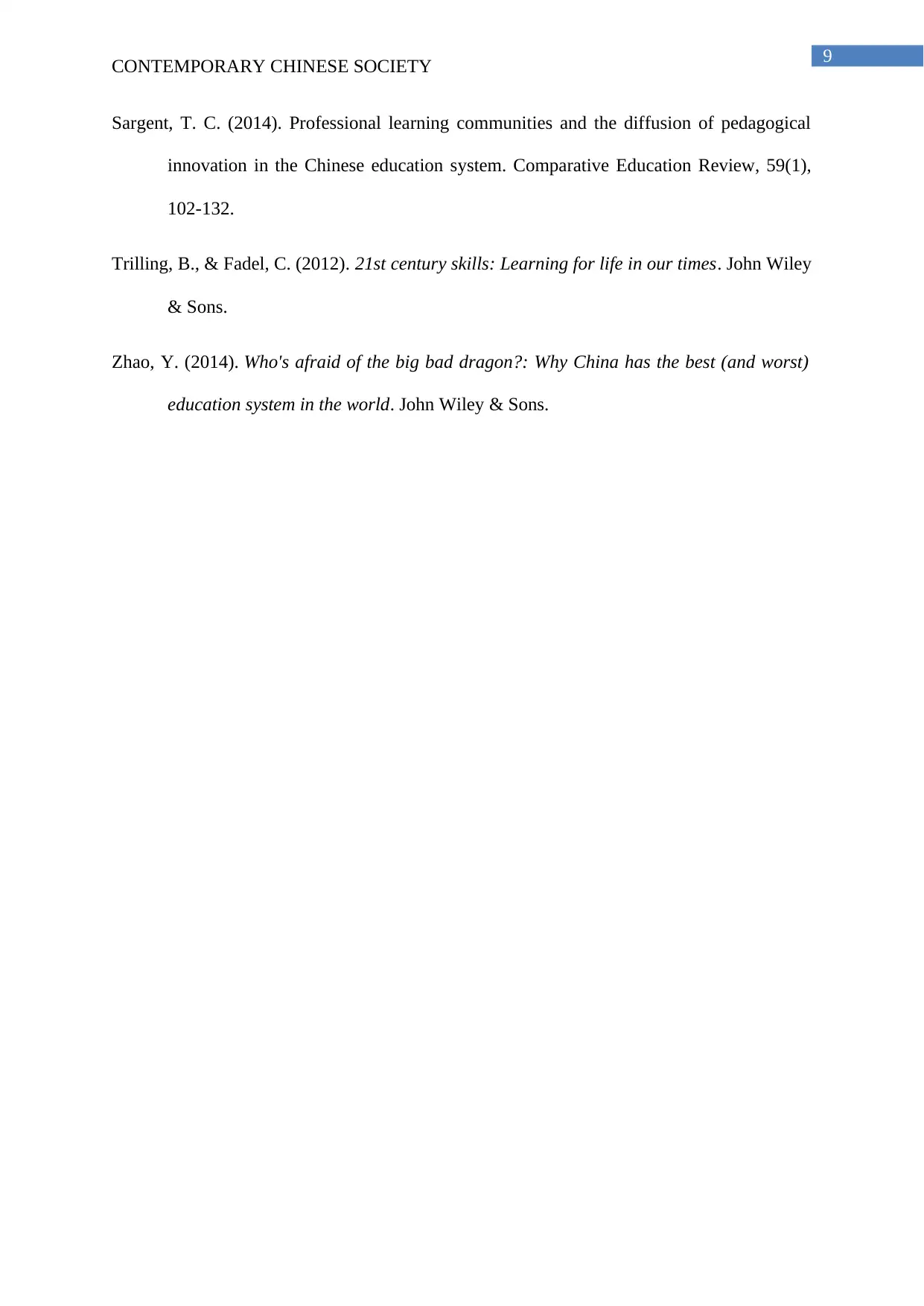
9
CONTEMPORARY CHINESE SOCIETY
Sargent, T. C. (2014). Professional learning communities and the diffusion of pedagogical
innovation in the Chinese education system. Comparative Education Review, 59(1),
102-132.
Trilling, B., & Fadel, C. (2012). 21st century skills: Learning for life in our times. John Wiley
& Sons.
Zhao, Y. (2014). Who's afraid of the big bad dragon?: Why China has the best (and worst)
education system in the world. John Wiley & Sons.
CONTEMPORARY CHINESE SOCIETY
Sargent, T. C. (2014). Professional learning communities and the diffusion of pedagogical
innovation in the Chinese education system. Comparative Education Review, 59(1),
102-132.
Trilling, B., & Fadel, C. (2012). 21st century skills: Learning for life in our times. John Wiley
& Sons.
Zhao, Y. (2014). Who's afraid of the big bad dragon?: Why China has the best (and worst)
education system in the world. John Wiley & Sons.
1 out of 10
Related Documents
Your All-in-One AI-Powered Toolkit for Academic Success.
+13062052269
info@desklib.com
Available 24*7 on WhatsApp / Email
![[object Object]](/_next/static/media/star-bottom.7253800d.svg)
Unlock your academic potential
Copyright © 2020–2025 A2Z Services. All Rights Reserved. Developed and managed by ZUCOL.





